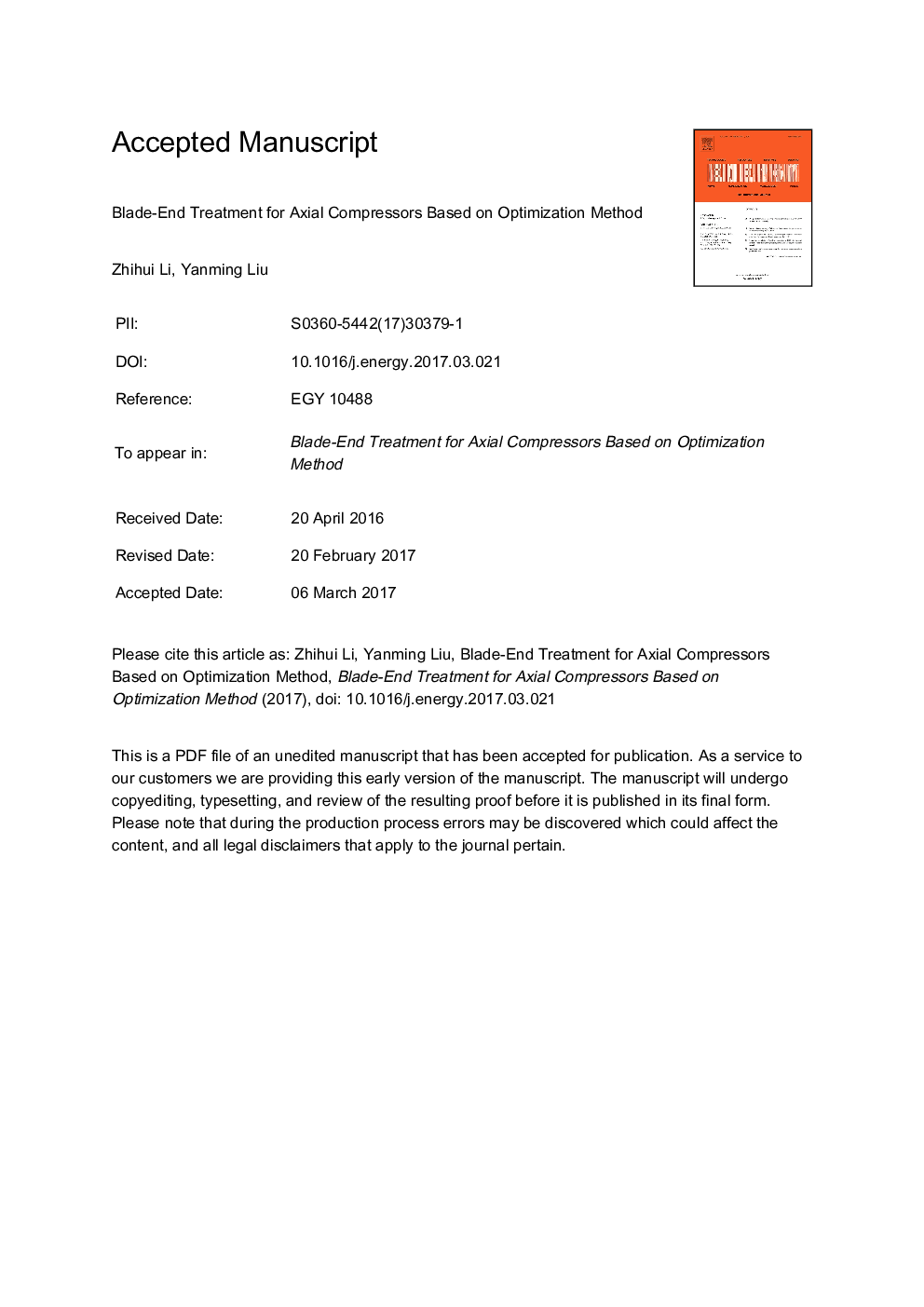| کد مقاله | کد نشریه | سال انتشار | مقاله انگلیسی | نسخه تمام متن |
|---|---|---|---|---|
| 5476980 | 1521425 | 2017 | 38 صفحه PDF | دانلود رایگان |
عنوان انگلیسی مقاله ISI
Blade-end treatment for axial compressors based on optimization method
ترجمه فارسی عنوان
درمان با تیغه برای کمپرسورهای محوری براساس روش بهینه سازی
دانلود مقاله + سفارش ترجمه
دانلود مقاله ISI انگلیسی
رایگان برای ایرانیان
کلمات کلیدی
درمان با تیغه بهینه سازی، الگوریتم ژنتیک، شبکه های عصبی مصنوعی، کمپرسور محوری
ترجمه چکیده
این مقاله با استفاده از الگوریتم بهینه سازی، کاربرد استفاده از درمان تیغه تا کمپرسورهای محوری را تمرکز می کند. درمان با تیغه، کاهش ضخامت دیوار را کاهش می دهد و حاشیه پایدار را با اصلاح شکل تیغه در نزدیکی منطقه دیوار انتهایی کاهش می دهد. این شامل سه نوع اقدامات کنترل جریان منفعل، یعنی خم شدن انتهای، پایان دادن به دو بعدی و درمان پایان دادن به سر و صدا است. اولا تأثیر درمان نابالغ بر اساس ادبیات باز که در طول 30 سال گذشته منتشر شده، مورد بررسی قرار گرفت. تمام این اثرات عمدتا تحت تاثیر عملکرد کمپرسور با تغییر توزیع بار باران در جهت یا جریان راست یا راست قرار می گیرند. بین جریان های بهبود یافته دیوار پایان یافته و جریان های نیمه دراز وخوابی بین دو طرف اختلاف وجود دارد. این اقدامات کمی برای اعمال تعادل مطلوب با توجه به تجربه مهندسی سنتی دشوار است. الگوریتم بهینه سازی یک دسترسی کارآمد برای حل این مسئله را به طور خودکار به دست آوردن حداکثر سود. دوم، یک نمونه بهینه سازی از مرحله 35 ناسا برای اعتبارسنجی در برابر مکانیسم های جریان خلاصه شده انجام شد. پارامترهای هندسی مطلوب دایره استاتور کانتینر در نزدیکی منطقه دیوار انتهایی با استفاده از یک مدل جایگزین همراه با یک الگوریتم ژنتیک برای بهینه سازی به دست آمد. در نهایت، نتایج بهینه سازی نشان داد که تیغه های پره ای بهینه، ترکیبی واضح از جلو و عقب، دو طرفه و انتهای خم شدن را نشان می دهد. تلفات فشار کلی استاتور با استفاده از روش بهینه سازی با درمان تیغه ای کاهش می یابد. کاهش قابل توجهی از تلفات در نزدیکی منطقه حوضچه، از فاصله 80٪ تا پوشش، رخ داده است، در حالیکه عملکرد در ناحیه نیمه متوسط تقریبا 50 تا 80٪ فاصله دارد. مکانیسم های حاصل از آن با دانش حاصل از بررسی ادبیات سازگار است و این امر راهنمایی معنی دار را در مورد فرآیند طراحی کمپرسور ارائه می دهد.
موضوعات مرتبط
مهندسی و علوم پایه
مهندسی انرژی
انرژی (عمومی)
چکیده انگلیسی
This paper concentrates on the application of blade-end treatment to axial compressors by means of the optimization algorithm. The blade-end treatment reduces the end wall losses and extends the stable margin by modifying blade shape near the end wall region. It contains three types of passive flow control measures, i.e., the end-bend, end-dihedral and end-sweep treatment. Firstly, the effects of blade-end treatment were reviewed based on the open literature published over the past 30 years. All of these effects essentially influence the compressor performance by changing the blading loading distributions in the streamwise or spanwise directions. There is a trade-off between the improved end wall flows and the deteriorated mid-span flows. It's difficult to quantitatively apply these measures to achieve an optimal balance according to the traditional engineering experience. Optimization algorithm provides an efficient access to resolve this issue by automatically obtaining the utmost benefit. Secondly, an optimization example of NASA Stage 35 was conducted to validate against the summarized flow mechanisms. The optimal geometry parameters of cantilever stator vane near the end wall region were obtained by employing a surrogate model in conjunction with a genetic algorithm for optimization. Finally, optimization results indicated that the optimal vane blade featured an obvious combination of forward end-sweep, positive end-dihedral and end-bend. The stator total pressure losses were reduced with the blade-end treatment based on optimization method. A significant reduction of loss occurred near the shroud region, from the 80% span to the casing, while the performance was degraded within the mid-span region, approximately 50%-80% span. The resulting mechanisms are consistent with the knowledge obtained from the literature review and this will provide meaningful guidance on the further compressor design process.
ناشر
Database: Elsevier - ScienceDirect (ساینس دایرکت)
Journal: Energy - Volume 126, 1 May 2017, Pages 217-230
Journal: Energy - Volume 126, 1 May 2017, Pages 217-230
نویسندگان
Zhihui Li, Yanming Liu,
